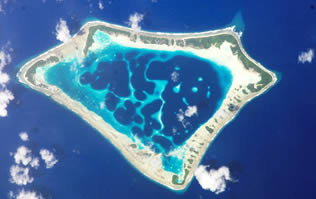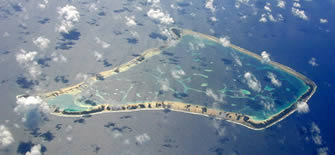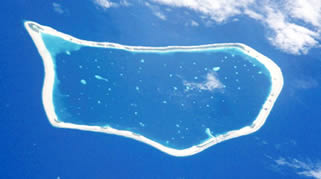
TokelauOriginally settled by Polynesian emigrants from surrounding island groups, the Tokelau Islands were made a British protectorate in 1889. They were transferred to New Zealand administration in 1925. Referenda held in 2006 and 2007 to change the status of the islands from that of a New Zealand territory to one of free association with New Zealand did not meet the needed threshold for approval. GeographyTokelau comprises three atolls in the South Pacific Ocean between 171° and 173° W longitude and 8° and 10° S latitude, approximately midway between Hawaii and New Zealand. Tokelau's claim to Swains is generally comparable to the Marshall Islands' claim to US-administered Wake Island, but the re-emergence of this somewhat dormant issue has been an unintended result of the United Nations' recent efforts to promote decolonization in Tokelau. Basically, Tokelauans have proved somewhat reluctant to push their national identity in the political realm: recent decolonization moves have mainly been driven from outside for ideological reasons. But at the same time, Tokelauans are reluctant to disown their common cultural identity with Swains Islanders who speak their language. Tokelau is in a different time zone from most of New Zealand, being 10 hours behind Coordinated Universal Time (UTC) rather than 12 hours in front, meaning a 22 hour time difference for much of the year (New Zealand has daylight saving time (DST) for part of the year while Tokelau never participates). Tokelau is in the same time zone as the Cook Islands and Hawaii rather than neighbouring Samoa and American Samoa. Geographic locations of Tokelau's atolls:
Demographics
HistoryArchaeological evidence indicates that the atolls of Tokelau — Atafu, Nukunonu, and Fakaofo — were settled about 1000 years ago, probably by voyages from Samoa, the Cook Islands and Tuvalu. Oral history traces local traditions and genealogies back several hundred years. Inhabitants followed Polynesian mythology with the local god Tui Tokelau; and developed forms of music and art. The three atolls functioned largely independently while maintaining social and linguistic cohesion. Tokelauan society was governed by chiefly clans, and there were occasional inter-atoll skirmishes and wars as well as inter-marriage. Fakaofo, the "chiefly island", held some dominance over Atafu and Nukunonu. Life on the atolls was subsistence-based, with reliance on fish and coconut.
On 29 October 1825 August R. Strong of the U.S.N Dolphin wrote of his crew's arrival at the atoll Nukunonu, "Upon examination, we found they had removed all the women and children from the settlement, which was quite small, and put them in canoes lying off a rock in the lagoon. They would frequently come near the shore, but when we approached they would pull off with great noise and precipitation." On 14 February 1835 Captain Smith of the United States whaler General Jackson records discovering Fakaofo, calling it "D'Wolf's Island".On 25 January 1841, the United States Exploring Expedition visited Atafu and discovered a small population living on the island. The residents appeared to be temporary, evidenced by the lack of a chief and the possession of double canoes (used for inter-island travel). They desired to barter, and possessed blue beads and a plane-iron, indicating previous interaction with foreigners. The expedition reached Nukunonu on 28 January 1841 but did not record any information about inhabitants. On 29 January 1841, the expedition discovered Fakaofo and named it "Bowditch". The islanders were found to be similar in appearance and nature to those in Atafu. Missionaries preached Christianity in Tokelau from 1845 to the EconomyTokelau's small size (three villages), isolation, and lack of resources greatly restrain economic development and confine agriculture to the subsistence level. The people rely heavily on aid from New Zealand - about $4 million annually - to maintain public services with annual aid being substantially greater than GDP. The principal sources of revenue come from sales of copra, postage stamps, souvenir coins, and handicrafts. Money is also remitted to families from relatives in New Zealand.
Communications
Sources and External linksGovernment
|
 They lie about 500 km (311 mi) north of Samoa. The islands are Atafu, at one time known as the Duke of York Group, Nukunonu, also the Duke of Clarence Group, and Fakaofo, once Bowditch Island. Between them they comprise a land area of 10.8 km². There are no ports or harbours. Tokelau lies in the Pacific typhoon belt. A fourth island that is culturally, historically, and geographically, but not politically, part of the Tokelau chain is
They lie about 500 km (311 mi) north of Samoa. The islands are Atafu, at one time known as the Duke of York Group, Nukunonu, also the Duke of Clarence Group, and Fakaofo, once Bowditch Island. Between them they comprise a land area of 10.8 km². There are no ports or harbours. Tokelau lies in the Pacific typhoon belt. A fourth island that is culturally, historically, and geographically, but not politically, part of the Tokelau chain is  Commodore John Byron discovered Atafu on 24 June 1765 and named it "Duke of York's Island." Parties onshore reported that there were no signs of current or previous inhabitants.Captain Edward Edwards, in knowledge of Byron's discovery, visited Atafu on 6 June 1791 in search of the Bounty mutineers. There were no permanent inhabitants, but houses contained canoes and fishing gear, suggesting the island was used as a temporary residence by fishing parties.On 12 June 1791, Edwards sailed southward and discovered Nukunonu, naming it "Duke of Clarence's Island". A landing party could not make contact with the people but saw "morais," burying places, and canoes with "stages in their middle" sailing across the lagoons.
Commodore John Byron discovered Atafu on 24 June 1765 and named it "Duke of York's Island." Parties onshore reported that there were no signs of current or previous inhabitants.Captain Edward Edwards, in knowledge of Byron's discovery, visited Atafu on 6 June 1791 in search of the Bounty mutineers. There were no permanent inhabitants, but houses contained canoes and fishing gear, suggesting the island was used as a temporary residence by fishing parties.On 12 June 1791, Edwards sailed southward and discovered Nukunonu, naming it "Duke of Clarence's Island". A landing party could not make contact with the people but saw "morais," burying places, and canoes with "stages in their middle" sailing across the lagoons. 1860s. French Catholic missionaries on Wallis Island (also known as 'Uvea) and missionaries of the Protestant London Missionary Society in Samoa used native teachers to convert the Tokelauans. Atafu was converted to Protestantism by the London Missionary Society, Nukunonu was converted to Catholicism and Fakofo was converted to both denominations. Peruvian slave traders arrived in 1863 and took nearly all (253) of the able-bodied men to work as labourers. The men died of dysentery and smallpox, and very few returned to Tokelau. With this loss, the system of governance became based on the "Taupulega", or "Councils of Elders", where individual families on each atoll were represented. During this time, Polynesian immigrants and American, Scottish, French, Portuguese and German beachcombers settled, marrying local women and repopulating the atoll
1860s. French Catholic missionaries on Wallis Island (also known as 'Uvea) and missionaries of the Protestant London Missionary Society in Samoa used native teachers to convert the Tokelauans. Atafu was converted to Protestantism by the London Missionary Society, Nukunonu was converted to Catholicism and Fakofo was converted to both denominations. Peruvian slave traders arrived in 1863 and took nearly all (253) of the able-bodied men to work as labourers. The men died of dysentery and smallpox, and very few returned to Tokelau. With this loss, the system of governance became based on the "Taupulega", or "Councils of Elders", where individual families on each atoll were represented. During this time, Polynesian immigrants and American, Scottish, French, Portuguese and German beachcombers settled, marrying local women and repopulating the atoll